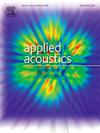Ultra-wideband acoustic meta-silencer to achieve target overall noise reduction levels: Design and experimental validation
IF 3.4
2区 物理与天体物理
Q1 ACOUSTICS
引用次数: 0
Abstract
An acoustic meta-silencer was designed using a generative design technique for ultra-wideband noise reduction, and its noise attenuation performance was experimentally validated. The target frequency range of the silencer and the target noise attenuation at each frequency were determined by considering the frequency-dependent noise characteristics of the existing exhaust system and its target overall noise reduction level. Generally, an acoustic meta-structure consists of unit cells that can block sound waves in frequency ranges corresponding to the band gaps in their dispersion curve plot. A new internal partition layout of the unit cells was proposed and optimized to make their band gaps as wide as possible. Various unit cells were generated, and their dispersion curve plots were obtained through acoustic analysis. Among the generated unit cells, several were systematically selected and sequentially arrayed so that their connected band gaps should cover the target frequency range of 100 to 6000 Hz. We proposed a design exploration algorithm to facilitate optimal design selection. An acoustic meta-silencer composed of five types of unit cells was successfully designed and fabricated, and its measured insertion loss curve demonstrates high and ultra-wideband noise attenuation performance.

实现目标整体降噪水平的超宽带声学元消声器:设计和实验验证
采用生成式设计技术设计了一种超宽带降噪声学元消声器,并对其降噪性能进行了实验验证。通过考虑现有排气系统的频率相关噪声特性及其目标整体降噪水平,确定消声器的目标频率范围和每个频率的目标降噪量。一般来说,声学元结构由单元格组成,这些单元格可以在其色散曲线中对应的带隙频率范围内阻挡声波。提出并优化了一种新的单晶胞内部分区布局,使其带隙尽可能宽。通过声学分析,生成了不同的单元胞,得到了它们的色散曲线。在生成的单元格中,有几个被系统地选择并顺序排列,使它们连接的带隙应覆盖100至6000 Hz的目标频率范围。我们提出了一种设计探索算法来促进最优设计选择。成功设计并制作了一种由5种单元格组成的元消声器,其插入损耗曲线显示出高、超宽带的降噪性能。
本文章由计算机程序翻译,如有差异,请以英文原文为准。
求助全文
约1分钟内获得全文
求助全文
来源期刊

Applied Acoustics
物理-声学
CiteScore
7.40
自引率
11.80%
发文量
618
审稿时长
7.5 months
期刊介绍:
Since its launch in 1968, Applied Acoustics has been publishing high quality research papers providing state-of-the-art coverage of research findings for engineers and scientists involved in applications of acoustics in the widest sense.
Applied Acoustics looks not only at recent developments in the understanding of acoustics but also at ways of exploiting that understanding. The Journal aims to encourage the exchange of practical experience through publication and in so doing creates a fund of technological information that can be used for solving related problems. The presentation of information in graphical or tabular form is especially encouraged. If a report of a mathematical development is a necessary part of a paper it is important to ensure that it is there only as an integral part of a practical solution to a problem and is supported by data. Applied Acoustics encourages the exchange of practical experience in the following ways: • Complete Papers • Short Technical Notes • Review Articles; and thereby provides a wealth of technological information that can be used to solve related problems.
Manuscripts that address all fields of applications of acoustics ranging from medicine and NDT to the environment and buildings are welcome.
 求助内容:
求助内容: 应助结果提醒方式:
应助结果提醒方式:


